b87cb97d66037d3aaf9104203a57f433.ppt
- Количество слайдов: 86

1 Introduction to Biology 174

2 "Ecological and Evolutionary Physiology" (BIOL 174) Winter 2016 Professor: Dr. Theodore Garland, Jr. Department of Biology Office: 2366 Spieth Hall Phone 827 -3524 - better for long questions tgarland@ucr. edu Office Hours: Tuesday 8: 30 -9: 30 and Wednesday 10: 30 -11: 30 A. M. in 2366 Spieth, or by appt.

3 Lecture: Tuesday and Thursday 2: 10 - 3: 30 A. M. in 2200 Spieth Hall Lectures will be posted on the "Blackboard" website ilearn. ucr. edu after the lecture is finished. Discussion: All are on Wed. 12: 10 -1: 00, 1: 10 -2: 00, 4: 10 -5: 00, 5: 10 -6: 00 PM Syllabus: Both Lecture and Discussion are posted on the course website. T. A. will go over with you.

4 Teaching Assistant: Mr. Jarren Kay Ph. D. candidate Department of Biology jkay 001@ucr. edu Office Hours: Monday 10: 30 -11: 30 PM Thursday 11 -12 PM in 2378 Spieth Hall, or by appointment

5 "Ecological and Evolutionary Physiology" (BIOL 174) Winter 2014 Catalog Description: Interactions between organisms and their environments, emphasizing coadaptation of physiological, morphological, and behavioral phenotypes. Topics include: allometry and scaling, metabolism and locomotion, heat and water exchange, evolution of endothermy, artificial selection experiments, and phylogenetically based statistical methods.

6 Some other Relevant Courses at UCR: "Animal Physiology" (BIOL 175) "Comparative Biomechanics" (BIOL 176) "Hormones and Behavior" (BIOL 178) "Animal Behavior" (BIOL 160) "Functional Anatomy of the Vertebrates" (BIOL 161 A, B)

7 Required Text: Readings posted on the "Blackboard" website ilearn. ucr. edu Don’t get behind on the reading! Exams will take some material directly from the reading, even if we have not discussed it in class! A copy of the first exam from a previous year is posted on the Blackboard website. Warning: Material covered will not be identical !!! Format may differ !!!

8 Grading Item Points % of Total -------------------------------------------------Pre-Course Survey (5 Jan) 20 8. 9 Midterm Exam 1 (28 Jan) 40 17. 8 Midterm Exam 2 (25 Feb) 40 17. 8 Final Exam 3 (14 Mar) 60 26. 7 Attendance 10 4. 4 Participation 10 4. 4 3 Quizzes (6 Jan, 3 Feb, 2 Mar) 15 (5 pts each) 6. 7 Paper Critique (20 Jan) 10 4. 4 Heritability Exercise (9 Mar) 20 8. 9 Discussion Section ------------------------------------------------Total Points 225 100

9 How grades are determined (of total points): > 90% = A > 80% = B > 70% = C + or - may also be used > 60% = D < 60% = F Scale may be moved down ("curved"), depending on distribution of total points at end of course. I cannot tell you in advance if this will happen or by how much.

10 Regrades: only within one week of when you get it back. We will regrade the whole thing, and points on ANY question may go up or down. Missed assignments: no make-ups are allowed, except for. . . Valid excuses, absences: tell us when it happens, or before. Do not wait until the end of the quarter! For medical absences, we need a note from your healthcare provider.

11 Lecture 2: Historical Development of Ecological and Evolutionary Physiology

12 Some highlights, not a thorough account. . .

C. Ladd Prosser: a founder of comparative physiology Edited 1950 volume, in which he outlined a broad agenda for comparative physiology: Prosser, C. L. , ed. 1950. Comparative animal physiology. W. B. Saunders Co. , Philadelphia. ix + 888 pp. 13

14 Five Big Goals: 1. Simply to describe how different kinds of animals meet their needs. = cataloging biological diversity "Biodiversity" often = how many species But perhaps equally important is how variable are those species, morphologically, physiologically, behaviorally? In other words, functional diversity. Recently, some have criticized this as "stamp collecting" and said that we must now move beyond that phase of simple description.

15 2. Use physiological information to reconstruct phylogenetic relationships of organisms. In principle, we could use physiological information just like we use morphological information or DNA sequences. In practice, has rarely been done, for 4 reasons: a. physiology doesn't leave many fossil cues b. it can't be measured on museum specimens c. it is difficult to measure as compared with morphology or DNA sequences d. more likely to be adaptive than DNA, so subject to parallel and convergent evolution, which confuses phylogenetic reconstruction.

16 3. To elucidate how physiology mediates interactions between organisms and their environments. = physiological ecology or ecological physiology

17 4. To identify "model systems" for studying particular physiological functions. = comparative physiology Examples: a. squid giant axons for nerve transmission b. rattlesnake tail shaker muscles because whole animal can be put in an NMR to measure in vivo changes in metabolites Conley, K. E. , and S. L. Lindstedt. 1996. Rattlesnake tail-shaking: minimal cost per twitch in striated muscle. Nature 383: 71 -73. c. ectothermic poikilotherms in general to study effects of temperature on physiology d. lizards to study effects of fever

18 5. Vague. . . but indicates that "kind of animal" can be used as a sort of "experimental variable. " Scientists routinely conduct experiments to test hypotheses. Nature conducts "natural experiments, " e. g. , putting animals in a desert, and we can use the results of these past experiments to understand how evolution occurs.

19 What's in a name? Noun conveys the main focus of the subdiscipline, adjective conveys the particular flavor. Comparative physiology tends to focus on physiology and how it varies among different organisms. Biomedical physiologists may see "comparative" as anything other than human beings or "the rat. " Physiological ecology focuses on ecology, and how physiology affects interactions between organisms and their environment.

20 Physiological ecology has always had an evolutionary component. Calow, P. , ed. 1987. Evolutionary physiological ecology. Cambridge University Press, Cambridge. 239 pp. , back cover: "Physiological ecology is concerned with the way that physiological traits fit organisms for the ecological circumstances in which they live, so there is always, by definition, an implicit evolutionary component to it. " Bennett, A. F. , and R. B. Huey. 1990. Studying the evolution of physiological performance. Pages 251 -284 in D. J. Futuyma and J. Antonovics, eds. Oxford surveys in evolutionary biology. Vol. 7. Oxford Univ. Press, Oxford. , p. 251: "The field of physiological ecology. . . is. . . fundamentally evolutionary to the extent that it considers how organisms came to be the way they are and how they might change in the future. "

21 Although Comparative Physiology and Physiological Ecology have always had evolutionary components, they were often an after thought. Typical mode of operation: make whatever physiological measurement they specialized in on some new, exotic or unusual organism. . .

22

23 … then tack on a paragraph about the adaptive (evolutionary) significance of whatever they found.

24 For Example: compare a temperate and an arctic-inhabiting bird. Any difference that was found would be attributed to the past effects of natural selecting (i. e. , an evolutionary adaptation). Possibilities of phylogenetic inheritance or random genetic drift were not considered. Often, a priori hypotheses were not tested. Or, if they were tested, it was not with the rigor that would be found in evolutionary biology (e. g. , only two species might be compared).

25 These sorts of inferences have been criticized as "just-so stories. "

"Just So Stories" by Rudyard Kipling Originally published 1902 http: //en. wikipedia. org/wiki/Just_So_Stories First published in 1902, these are origin stories, fantastic accounts of how various phenomena came about. 26

27 HOW THE ELEPHANT GOT ITS TRUNK HOW THE WHALE GOT HIS THROAT HOW THE CAMEL GOT HIS HUMP HOW THE RHINOCEROS GOT HIS SKIN HOW THE LEOPARD GOT HIS SPOTS

28 So, the standards of evidence and interpretation used by evolutionary biologists were not being employed by most physiologists who wished to say something about the evolution of their favorite physiological system or organism. In short, many physiologists were practicing evolutionary biology without a license.

29 Evolutionary physiology is a new subdiscipline that incorporates much of Prosser's (1950) five objectives, but with more rigorous evolutionary tools and definitions. This course will emphasize the methods of ecological and evolutionary physiology and their conceptual background, rather than providing lots of empirical facts concerning how different kinds of organisms make their living or have evolved physiologically. Also, I will show lots of examples. Try to remember the general point of these examples. And we will need some definitions …

30 For example, the word "adaptation" has several meanings, with two being common in biology: 1. the genetic, evolutionary process of traits that change across generations because of natural selection and consequent changes in gene frequencies (a property of populations); Bennett, A. F. 1997. Adaptation and the evolution of physiological characters. Pages 3 -16 in W. H. Dantzler, ed. Handbook of physiology. Section 13: comparative physiology. Vol. I. Oxford Univ. Press, New York.

31 2. within-individual changes in response to environmental perturbations = phenotypic plasticity (these changes are not passed on to offspring) a. Acclimatization = in the field b. Acclimation = in the lab Often these changes are reversible (phenotypic flexibility) May occur at any point in the lifecycle, but those occurring early, during "critical periods, " may be less reversible. . . Piersma, T. , and J. A. van Gils. 2011. The flexible phenotype: a body-centred integration of ecology, physiology, and behaviour. Oxford Univ. Press, Oxford, U. K. ix + 238 pp.

Example with Laboratory House Mice: Mohammed A. Al-kahtani. 2003. Ph. D. in Zoology at the Univ. of Wisconsin - Madison. "Evolutionary and Phenotypic Plasticity of Mammalian Kidney: Using the Laboratory House Mouse as a Model. " Currently faculty at King Faisal University, Saudi Arabia. 32

33 Three Goals: Determine how mice "adapt" ontogenetically to reduced water availability. Create a "model" for studying kidney function. Create a "model" for studying desert rodents or other desert mammals. Eventually apply to "conservation physiology" in the context of captive breeding progams for endangered gazelle.

34 Two groups, starting at weaning (21 days of age) FW-J = Free Water-Juveniles WR-J = Water Restricted-Juveniles

35 Method for Restricting Water

Daily water consumption in both juvenile groups Values are means + standard deviations 36

Food intake significantly decreased in water-restricted group. 37

Water restriction stunted the growth of water-restricted group. 38
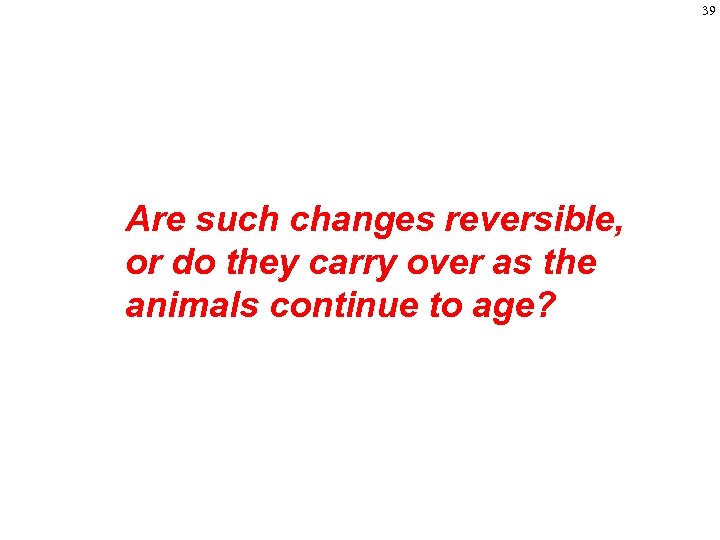
39 Are such changes reversible, or do they carry over as the animals continue to age?

40 Reversal Experiment
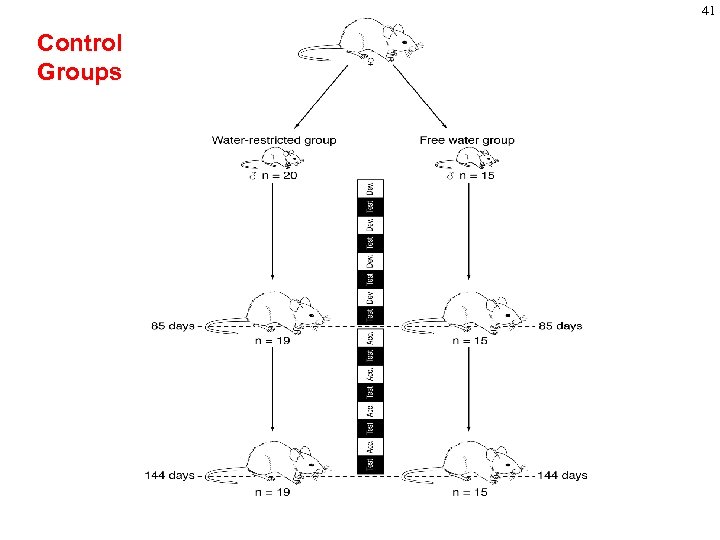
41 Control Groups
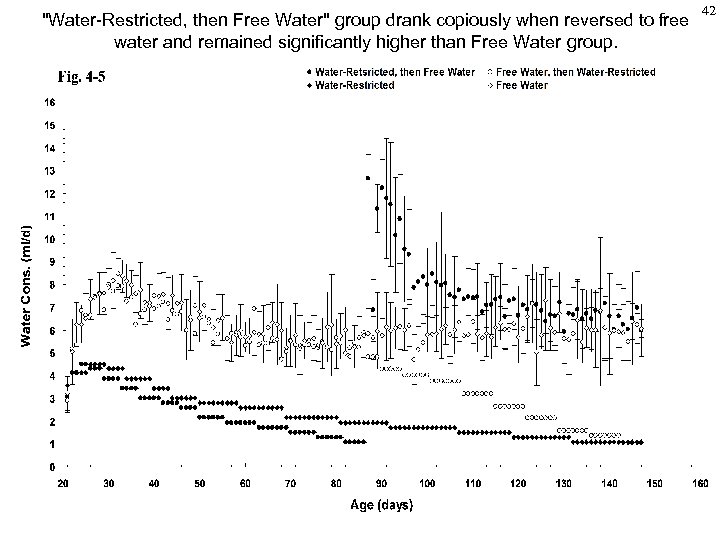
"Water-Restricted, then Free Water" group drank copiously when reversed to free water and remained significantly higher than Free Water group. 42

Food intake is intimately linked with water consumption in house mice. 43

The effects of early-life water restriction are not completely reversible. 44
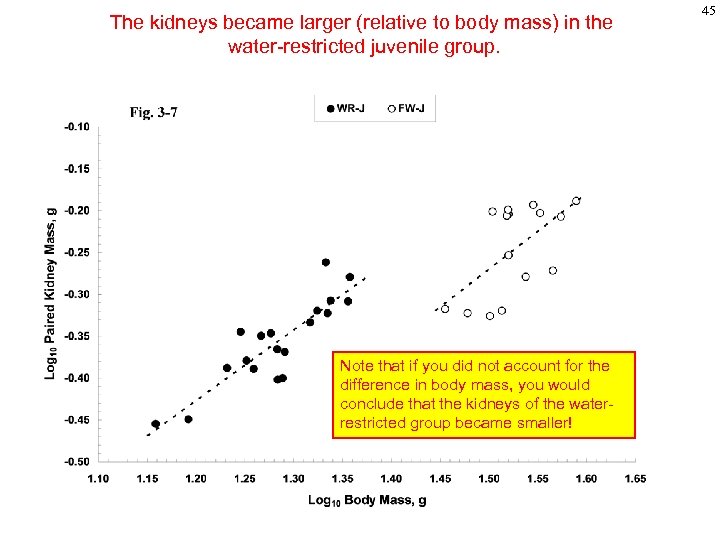
The kidneys became larger (relative to body mass) in the water-restricted juvenile group. Note that if you did not account for the difference in body mass, you would conclude that the kidneys of the waterrestricted group became smaller! 45

The urine was much more concentrated in the water-restricted juvenile group. 46
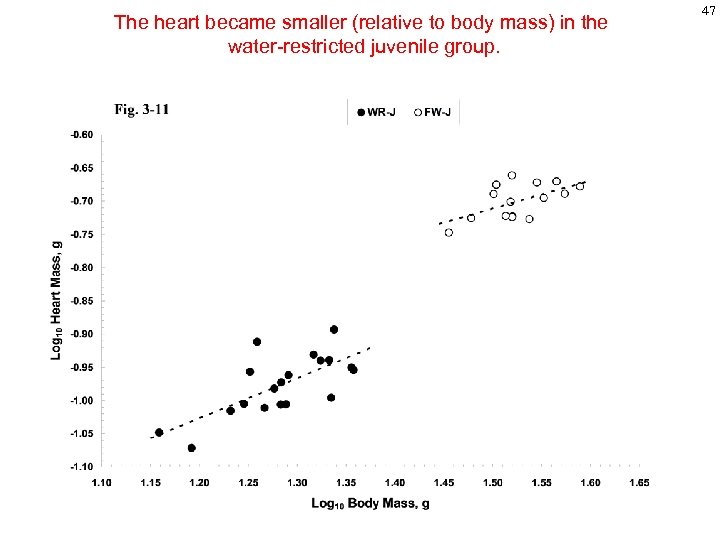
The heart became smaller (relative to body mass) in the water-restricted juvenile group. 47
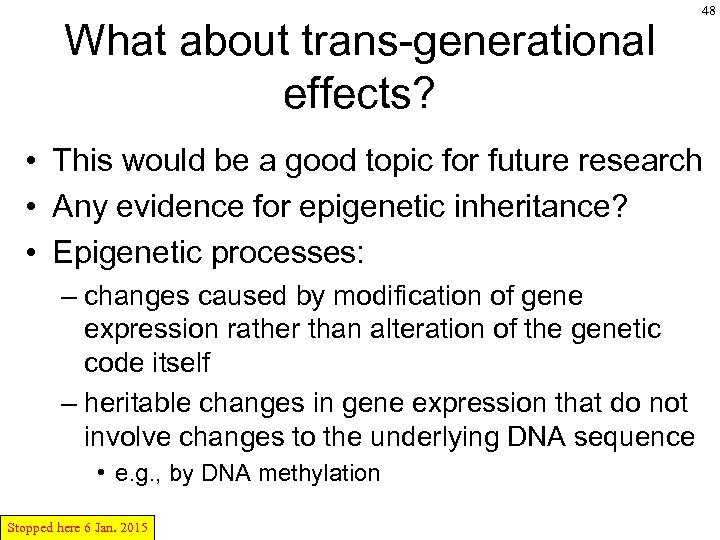
What about trans-generational effects? 48 • This would be a good topic for future research • Any evidence for epigenetic inheritance? • Epigenetic processes: – changes caused by modification of gene expression rather than alteration of the genetic code itself – heritable changes in gene expression that do not involve changes to the underlying DNA sequence • e. g. , by DNA methylation Stopped here 6 Jan. 2015

49 The origin of modern "Evolutionary Physiology"
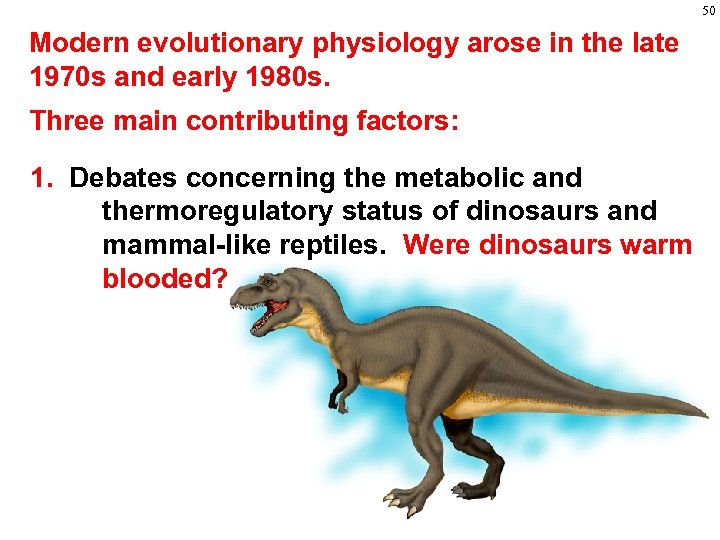
50 Modern evolutionary physiology arose in the late 1970 s and early 1980 s. Three main contributing factors: 1. Debates concerning the metabolic and thermoregulatory status of dinosaurs and mammal-like reptiles. Were dinosaurs warm blooded?

51 2. attempts to integrate quantitative genetic perspectives into evolutionary biology and behavioral ecology: a. focus on individual variation as raw material for natural selection, not just "noise" b. attempts to estimate heritability of traits c. attempts to measure selection acting in nature Bumpus, H. C. 1899. The elimination of the unfit as illustrated by the introduced sparrow, Passer domesticus. Mar. Biol. Lab. , Biol. Lect. (Woods Hole, 1898), pp. 209 -226.

52 3. attempts to integrate phylogenetic perspectives into comparative biology:
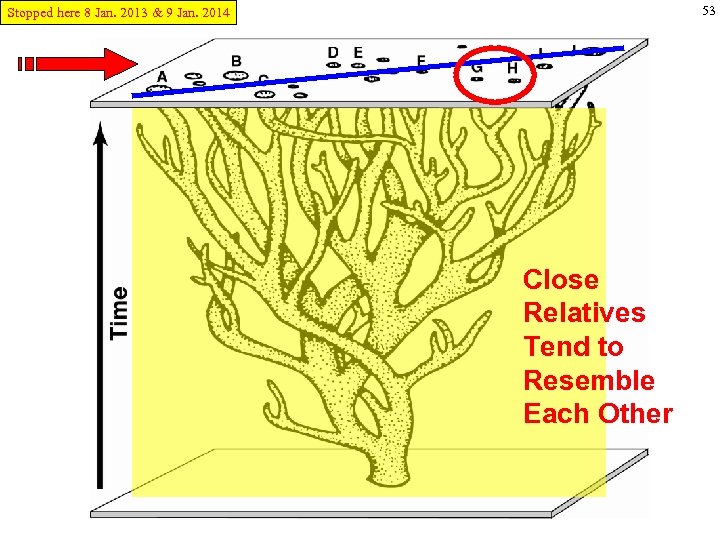
53 Stopped here 8 Jan. 2013 & 9 Jan. 2014 Close Relatives Tend to Resemble Each Other

54 Evolution from a Physiological Perspective and vice versa: recurring themes in ecological and evolutionary physiology 1. How do Different Kinds of Organisms Work? a. Discover general principles of organismal function, such as homeostasis or the scaling of metabolic rate with body mass. b. Find exceptions to the rules, species that are "outliers" from the general trend. c. Determine whethere exist multiple solutions to a given adaptive problem.

55 Because all organisms on this planet are descended from common ancestors - and probably from a single common ancestor general biological principles are likely to occur in a strongly hierarchical (phylogenetic) pattern. Related organisms tend to resemble each other in terms of how they are built and how they do things; for example, use of DNA as a genetic material, structure of eukaryotic cell membranes, responses to changes in ambient temperature by mammals.

56 Evolution from a Physiological Perspective and vice versa: recurring themes in ecological and evolutionary physiology 1. How do Different Kinds of Organisms Work? a. Discover general principles of organismal function, such as homeostasis or the scaling of metabolic rate with body mass. b. Find exceptions to the rules, species that are "outliers" from the general trend. c. Determine whethere exist multiple solutions to a given adaptive problem.

57 c. Determine whethere exist multiple solutions to a given adaptive problem. What are some of the "solutions" that animals use to live in hot, dry deserts? Are these evolved differences or phenotypic plasticity? What about plants?
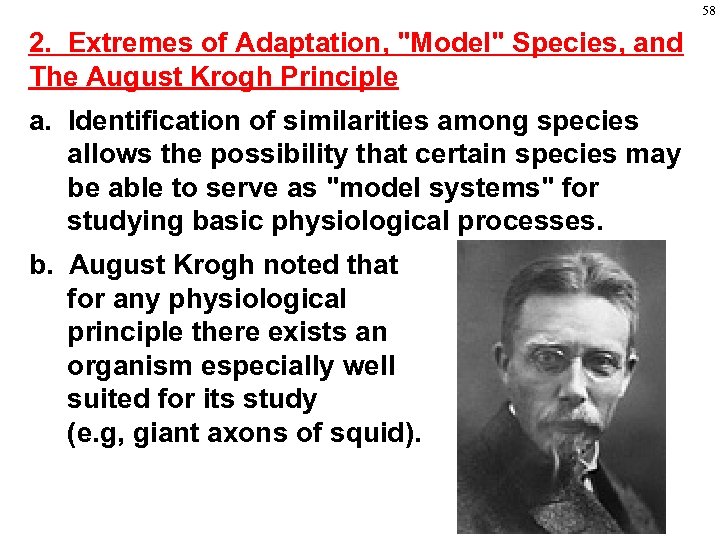
58 2. Extremes of Adaptation, "Model" Species, and The August Krogh Principle a. Identification of similarities among species allows the possibility that certain species may be able to serve as "model systems" for studying basic physiological processes. b. August Krogh noted that for any physiological principle there exists an organism especially well suited for its study (e. g, giant axons of squid).

59 Squid can contract the muscles of the mantle simultaneously, thus forcing sea water through the mantle aperture and causing the body to move forward. An important part of this system is a big ganglion from which departs a giant axon. The axon sends signals to all muscles involved in the process, and is much thicker than any axon of other animals. Accordingly, it has been used in many studies of nerve signalling, e. g. : Hodgkin A. L. & Huxley A. F. 1952. Propagation of electrical signals along giant nerve fibers. Proc. R. Soc. Lond. , B Biol. Sci. 140: 177 -183. Giant squid (Architeuthis) are enormous molluscs from the deep sea. The maximal length (from the dorsal fin to the end of a tentacle) is estimated to be 13 m in females and 10 m in males. These animals have a highly sophisticated nervous system, highly developed brains and excellent eyes.

60 c. Similarly, organisms living in extreme environments are especially likely to exhibit clear examples of evolutionary adaptation, because of the presumably intense past selection. They can also serve to illustrate the range of evolutionary possibilities. But we must remember that the organisms alive today -- and hence available for physiological study -- are but a small fraction of what has existed. We have no guarantee that we can observe the range of possibilities even among the most extreme of living species.

61 Example: Dinosaurs, such as Spinosaurus http: //www. biology. ucr. edu/people/faculty/Garland/Spinosaurus_30_Theo_29_Sep_2004. jpg
![62 Example: the largest terrestrial mammal ever (Indricotherium [formerly Baluchitherium]) was much larger than 62 Example: the largest terrestrial mammal ever (Indricotherium [formerly Baluchitherium]) was much larger than](https://present5.com/presentation/b87cb97d66037d3aaf9104203a57f433/image-62.jpg)
62 Example: the largest terrestrial mammal ever (Indricotherium [formerly Baluchitherium]) was much larger than living elephants, mammoths or mastodons. An extinct hornless rhinoceros that lived in the Oligocene epoch (3020 million years ago). Fossilized remains found in central Asia show that it was over 5 m high, with a heavy giraffe-like body.

63 Giant birds (both flying and flightless) once existed, giant dragonflies. And then there were plesiosaurs, ichthyosaurs, etc. Many transitional forms are now extinct. Environmental conditions differed as well, e. g. , temperature and atmospheric oxygen and carbon dioxide.

Environmental conditions differed as well, e. g. , atmospheric oxygen. http: //geology. com/usgs/amber/oxygen-level-chart. gif 64

Environmental conditions differed as well, e. g. , temperature & atmospheric carbon dioxide. http: //deforestation. geologist-1011. net/Phanerozoic. CO 2 -Temperatures. png 65
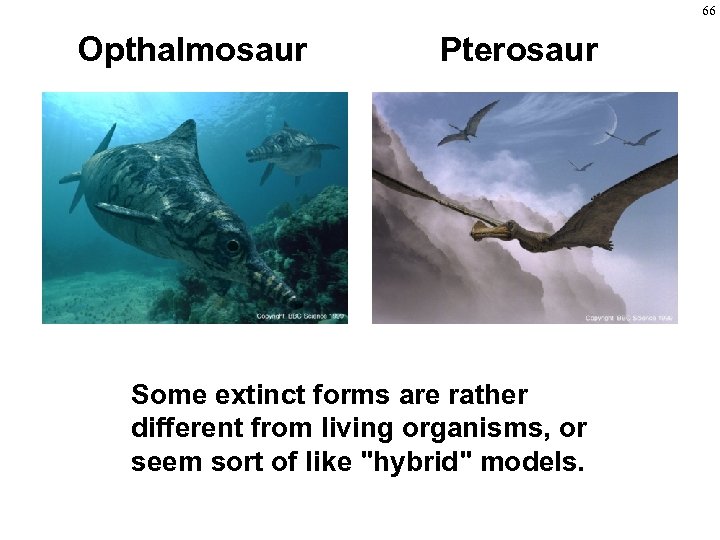
66 Opthalmosaur Pterosaur Some extinct forms are rather different from living organisms, or seem sort of like "hybrid" models.

67 A recently-extinct species that demonstrated convergent evolution with placental wolves.

68 Plate 8. 2 The last living Plate 9. 1 Rear view of the Tasmanian tiger, Hobart Zoo, 1933. last living Tasmanian tiger, Hobart Zoo, 1933. Died night of 7 September 1936 Stopped here 7 Jan. 2016
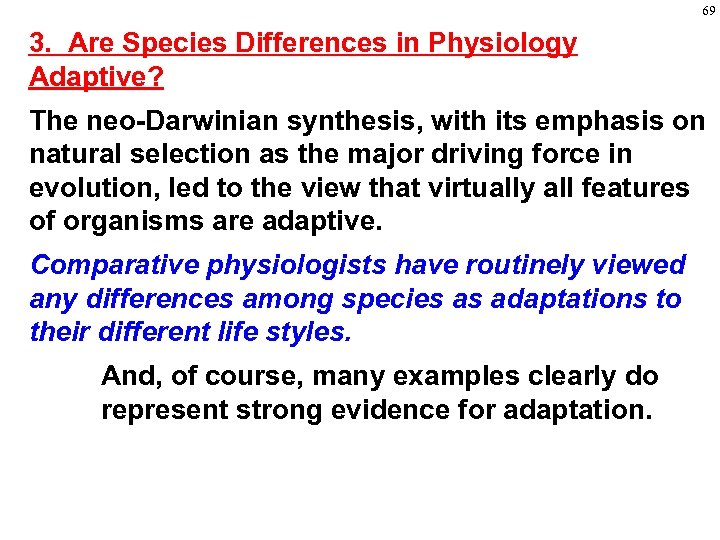
69 3. Are Species Differences in Physiology Adaptive? The neo-Darwinian synthesis, with its emphasis on natural selection as the major driving force in evolution, led to the view that virtually all features of organisms are adaptive. Comparative physiologists have routinely viewed any differences among species as adaptations to their different life styles. And, of course, many examples clearly do represent strong evidence for adaptation.
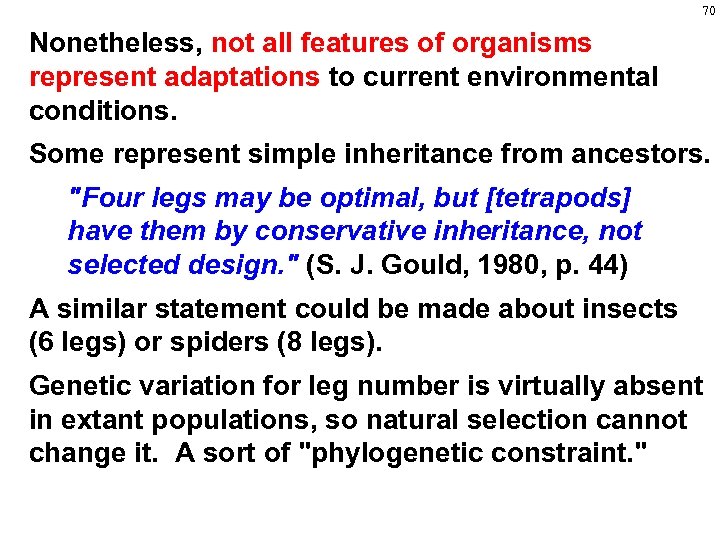
70 Nonetheless, not all features of organisms represent adaptations to current environmental conditions. Some represent simple inheritance from ancestors. "Four legs may be optimal, but [tetrapods] have them by conservative inheritance, not selected design. " (S. J. Gould, 1980, p. 44) A similar statement could be made about insects (6 legs) or spiders (8 legs). Genetic variation for leg number is virtually absent in extant populations, so natural selection cannot change it. A sort of "phylogenetic constraint. "
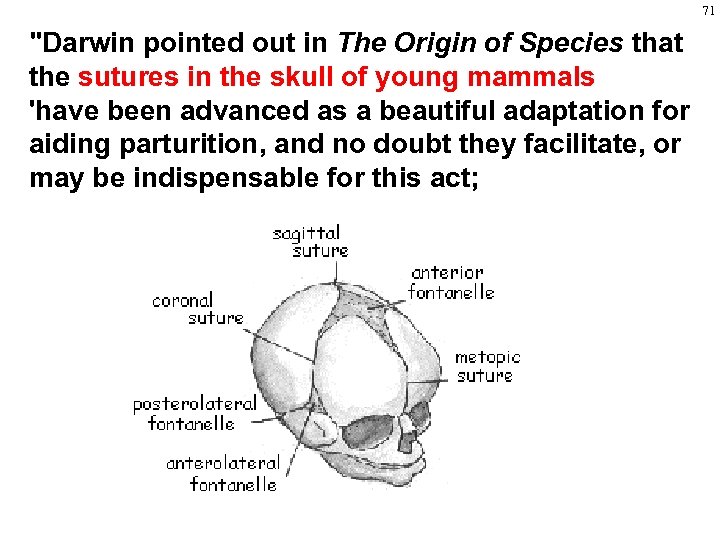
71 "Darwin pointed out in The Origin of Species that the sutures in the skull of young mammals 'have been advanced as a beautiful adaptation for aiding parturition, and no doubt they facilitate, or may be indispensable for this act;

72 "Darwin pointed out in The Origin of Species that the sutures in the skull of young mammals 'have been advanced as a beautiful adaptation for aiding parturition, and no doubt they facilitate, or may be indispensable for this act; but as sutures occur in the skulls of young birds and reptiles, which have only to escape from a broken egg, we may infer that this structure has arisen from the laws of growth, and has been taken advantage of in the parturition of the higher animals. '

73 Gould and Vrba (1982) have offered the term exaptation to describe features that now enhance fitness, but were not built by natural selection for their current role. " (Futuyma, 1986, p. 257)

74 4. Are Organisms Optimally Designed? In addition to presuming that most features of organisms are adaptations, a common perspective in comparative physiology is to view organisms as optimally designed, i. e. , more-or-less perfectly adapted in some sense. "We do not think a functional explanation complete until we can show that a structure or movement is optimal (by some plausible criterion) for the proposed function. " (Alexander, 1988, p. 237) "Evolution by natural selection is a process of optimization. " (Alexander, 1996, p. 2)
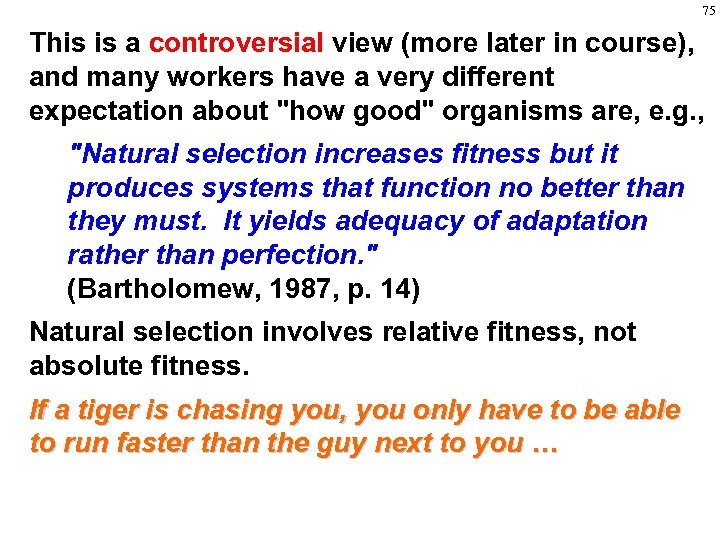
75 This is a controversial view (more later in course), and many workers have a very different expectation about "how good" organisms are, e. g. , "Natural selection increases fitness but it produces systems that function no better than they must. It yields adequacy of adaptation rather than perfection. " (Bartholomew, 1987, p. 14) Natural selection involves relative fitness, not absolute fitness. If a tiger is chasing you, you only have to be able to run faster than the guy next to you …
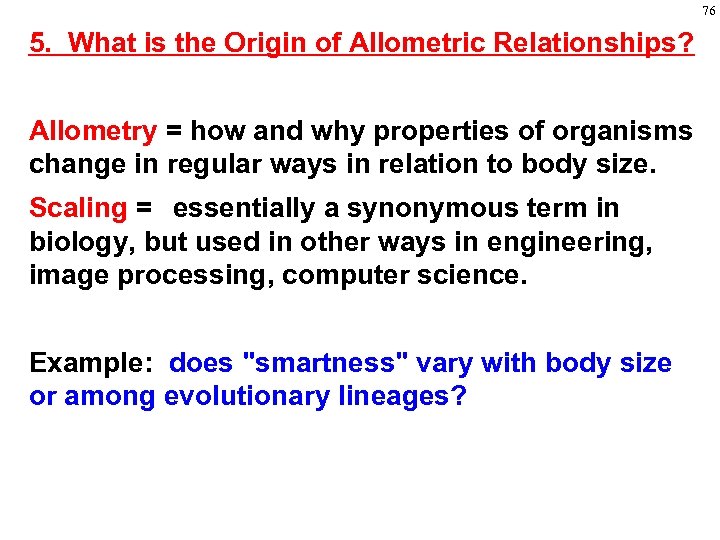
76 5. What is the Origin of Allometric Relationships? Allometry = how and why properties of organisms change in regular ways in relation to body size. Scaling = essentially a synonymous term in biology, but used in other ways in engineering, image processing, computer science. Example: does "smartness" vary with body size or among evolutionary lineages?

77 Slope = 1. 00 log-log axes Largeer Slope = 0. 67 animals have relatively smaller brains.

78 log-log axes Vertical deviations from "line of best fit" (residuals) indicate deviation from general effect of body size.

79 Extra Slides Follow
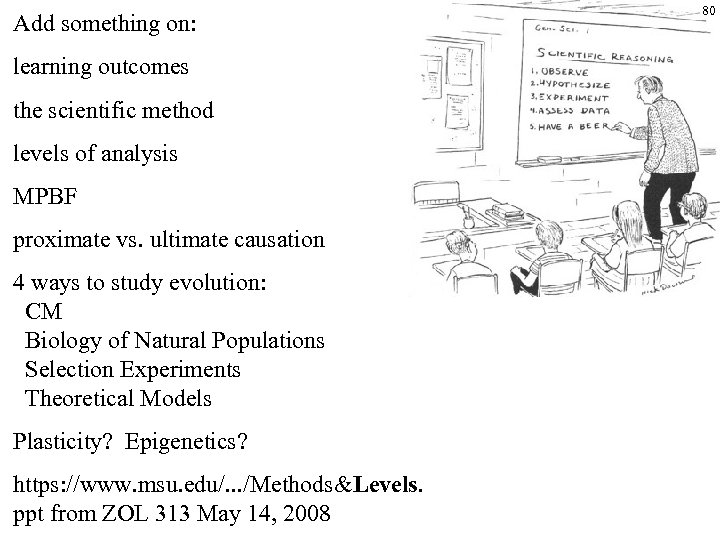
Add something on: learning outcomes the scientific method levels of analysis MPBF proximate vs. ultimate causation 4 ways to study evolution: CM Biology of Natural Populations Selection Experiments Theoretical Models Plasticity? Epigenetics? https: //www. msu. edu/. . . /Methods&Levels. ppt from ZOL 313 May 14, 2008 80

4 Ways to Study Physiological Evolution 1. Phylogenetic Comparisons of Species (or populations) Shows what has happened in past evolution 2. Biology of Natural Populations: extent of individual variation (repeatability) heritability and genetic correlations natural and sexual selection field manipulations and introductions Shows present evolution in action 3. Selection Experiments Shows, experimentally, what might happen during future evolution 4. Compare Real Organisms with Theoretical Models Shows how close selection can get to producing optimal solutions 81
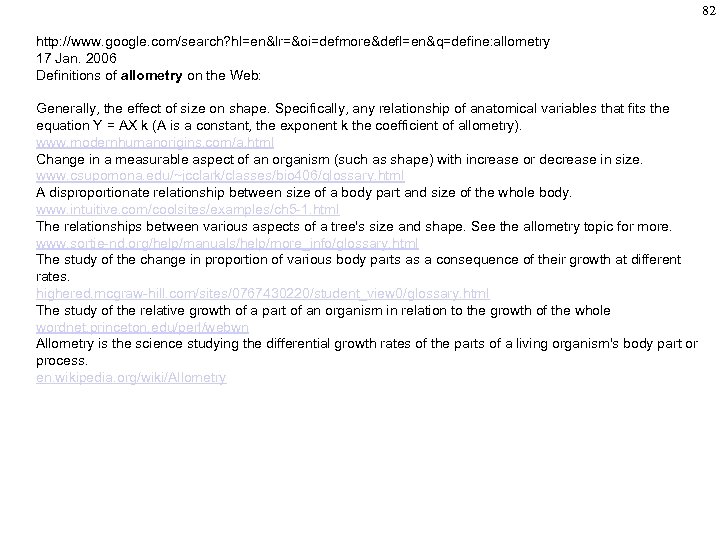
82 http: //www. google. com/search? hl=en&lr=&oi=defmore&defl=en&q=define: allometry 17 Jan. 2006 Definitions of allometry on the Web: Generally, the effect of size on shape. Specifically, any relationship of anatomical variables that fits the equation Y = AX k (A is a constant, the exponent k the coefficient of allometry). www. modernhumanorigins. com/a. html Change in a measurable aspect of an organism (such as shape) with increase or decrease in size. www. csupomona. edu/~jcclark/classes/bio 406/glossary. html A disproportionate relationship between size of a body part and size of the whole body. www. intuitive. com/coolsites/examples/ch 5 -1. html The relationships between various aspects of a tree's size and shape. See the allometry topic for more. www. sortie-nd. org/help/manuals/help/more_info/glossary. html The study of the change in proportion of various body parts as a consequence of their growth at different rates. highered. mcgraw-hill. com/sites/0767430220/student_view 0/glossary. html The study of the relative growth of a part of an organism in relation to the growth of the whole wordnet. princeton. edu/perl/webwn Allometry is the science studying the differential growth rates of the parts of a living organism's body part or process. en. wikipedia. org/wiki/Allometry

83 http: //www. google. com/search? hl=en&lr=&oi=defmore&defl=en&q=define: scaling 17 Jan. 2006 Definitions of scaling on the Web: The act of arranging in a graduated series act of measuring or arranging or adjusting according to a scale ascent by or as if by a ladder wordnet. princeton. edu/perl/webwn In Euclidean geometry, scaling is an affine, linear transformation that can enlarge or diminish an object by certain factors. See also homothety. en. wikipedia. org/wiki/Scaling_(geometry) In computer networking, scaling is the ability for a network to continue to function with limited or no degredation in performance as the number of users on the network increases. en. wikipedia. org/wiki/Scaling_(computer_network) The measuring of lengths and diameters of logs and calculating deductions for defect to determine volume. www. woodlot. bc. ca/swp/myw/html/21_Glossary. htm A means of calculating the amount of enlargement or reduction necessary to accommodate a photograph within the area of a design. www. purdue. edu/printingservices/support/glossary/glossrtoz. htm The enlargement or reduction of an image or copy to fit a specific area. www. millerbrosengraving. com/resources/glossary. html Determining the proper size of an image to be produced (or reduced/enlarged). It is important that both directions be scaled in order to ensure proper fit in the final reproduction. www. relyprint. com/help_dictionary. html Reduction or enlargement of artwork, which can be proportional (most frequently used) or disproportional. In desktop publishing, optimal scaling of bitmaps is reduction or enlargement that will avoid or reduce moiré patterns. www. printingyoucantrust. com/glossary. cfm Determining the proper size of an image to be reduced or enlarged to fit an area. www. careydigital. com/support/glossaryr-s. html

84 … then tack on a paragraph about the adaptive (evolutionary) significance of whatever they found. For example, consider the last paragraph of a study that compared goats with dogs: "In conclusion, we show that highly aerobic mammals like dogs possess an “aerobic albumin” with elevated fatty acid binding capacity. This adaptation allows them to support much higher rates of circulatory fatty acid transport than sedentary goats, but further research is needed to determine whether all endurance-adapted species have evolved such albumin. "

85 … then tack on a paragraph about the adaptive (evolutionary) significance of whatever they found. For example, consider the last paragraph of a study that compared goats with dogs: "In conclusion, we show that highly aerobic mammals like dogs possess an “aerobic albumin” with elevated fatty acid binding capacity. This adaptation allows them to support much higher rates of circulatory fatty acid transport than sedentary goats, but further research is needed to determine whether all endurance -adapted species have evolved such albumin. " How do we know dogs are endurance adapted?

86 … then tack on a paragraph about the adaptive (evolutionary) significance of whatever they found. For example, consider the last paragraph of a study that compared goats with dogs: "In conclusion, we show that highly aerobic mammals like dogs possess an “aerobic albumin” with elevated fatty acid binding capacity. This adaptation allows them to support much higher rates of circulatory fatty acid transport than sedentary goats, but further research is needed to determine whether all endurance-adapted species have evolved such albumin. " But what else differs between dogs and goats?
b87cb97d66037d3aaf9104203a57f433.ppt